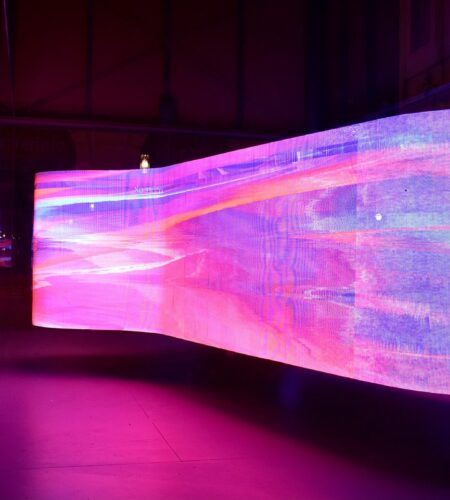LED displays are known for their brightness, energy efficiency, and long lifespan. From vibrant digital billboards to the screens in our conference rooms, they are a reliable choice for visual communication.
However, like any piece of technology, they can sometimes run into problems. Understanding the common issues and how to address them can save you time, money, and frustration.
This post will walk you through the most frequent LED display issues you might encounter. We’ll cover everything from flickering screens and dead pixels to more complex module failures.
By the end, you will have a clearer understanding of basic troubleshooting steps and know when it’s time to call in a professional for LED repair.
Flickering or Unstable Images
One of the most distracting display issues is a flickering screen. This can make content unreadable and create a poor viewing experience. The problem often stems from a few key areas.
Potential Causes
- Loose Connections: The most common culprit is a loose or faulty data or power cable connecting the display modules or the control system.
- Power Supply Issues: An unstable or failing power supply unit (PSU) can cause inconsistent power delivery, leading to flickering.
- Driver or Software Problems: Outdated or corrupted driver software on the control system can also lead to instability in the displayed image.
How to Fix It
- Check All Cables: Start by ensuring all data and power cables are securely connected at both ends. If you suspect a faulty cable, try swapping it with a known good one.
- Inspect the Power Supply: If the flickering continues, examine the power supply. Look for any visible signs of damage. You can also use a multimeter to test if it’s providing a stable voltage according to the manufacturer’s specifications.
- Update Software and Drivers: Make sure the control system software and display drivers are up-to-date. Visit the manufacturer’s website for the latest versions.
Dead Pixels or Dark Spots
Individual pixels or small groups of pixels can sometimes fail, creating dark or unlit spots on your display. While a single dead pixel might be unnoticeable from a distance, clusters of them can be very disruptive.
Potential Causes
- LED Failure: The individual LED light within a pixel has burned out or malfunctioned.
- Driver IC Issues: The driver integrated circuit (IC) that controls the pixel might have failed, preventing it from lighting up.
- Soldering Problems: A poor solder joint connecting the pixel to the circuit board can interrupt the electrical connection.
How to Fix It
Fixing dead pixels often requires a degree of technical skill. For a single pixel, replacement is sometimes possible but can be intricate.
If an entire section is dark, it often points to a problem with the driver IC or the module itself, which may require professional LED module repair. Before calling for service, try power cycling the display, as this can sometimes reset minor glitches.
Incorrect or Distorted Colors
When your LED display shows incorrect colors, such as a red tint over the entire screen or random patches of discoloration, it can ruin the visual impact of your content.
Potential Causes
- Signal Interference: Faulty or low-quality data cables can lead to signal degradation, causing color inaccuracies.
- Configuration Settings: Incorrect color settings in the control software can cause the display to render colors improperly.
- LED Aging: Over time, LEDs can age at different rates. For example, the blue LEDs might dim faster than the red and green ones, leading to a color shift.
How to Fix It
- Verify Cable Integrity: Replace the data cable connecting the control system to the display to rule out signal issues.
- Review Software Settings: Open the control software and check the color calibration and configuration settings. Resetting them to default or running a new calibration process often solves the problem.
- Perform Color Calibration: Most professional LED systems have a calibration feature. Running this can help rebalance the color output across the entire display.
Complete Module or Section Failure
Sometimes an entire module or a large section of the display goes black. This is a more serious issue than a few dead pixels and points to a more significant hardware failure. This type of problem is a key reason for professional lighting maintenance.
Potential Causes
- Module Power Failure: The power supply dedicated to that specific LED module may have failed.
- Data Signal Loss: The module might not be receiving a data signal from the control system or the preceding module.
- Faulty Module: The internal components of the LED module itself could be damaged.
How to Fix It
- Check Connections: First, inspect the power and data cables leading to the failed module. Ensure they are firmly plugged in.
- Test with a Spare: If you have a spare LED module, swap it with the malfunctioning one. If the new module works, the original one is faulty and needs LED module repair or replacement. If the new module also fails to light up, the issue likely lies with the cabling or the sending unit.
- Inspect the Signal Path: LED modules are often connected in a daisy chain. A failure in one module’s data output can affect all subsequent modules in the chain. Check the module that comes just before the dark section.
Overheating and Shutdowns
LED displays generate heat, and if not properly managed, this can lead to overheating. Excessive heat can cause performance issues, premature aging of components, and even automatic shutdowns as a safety measure.
Potential Causes
- Poor Ventilation: Blocked vents or insufficient airflow around the display can trap heat.
- Fan Failure: If the display has cooling fans, one or more may have stopped working.
- High Ambient Temperature: Operating the display in an environment that is already very hot can overwhelm its cooling system.
How to Fix It
- Ensure Proper Ventilation: Check that the display’s ventilation ports are not obstructed by walls, objects, or dust buildup. Clean them regularly.
- Check Cooling Fans: Listen to ensure all cooling fans are running. If a fan has failed, it will need to be replaced.
- Control the Environment: If possible, improve the airflow in the room or lower the ambient temperature. For outdoor displays, ensure any built-in cooling systems are functioning correctly.
Maintaining Your Display’s Performance
Proactive lighting maintenance is the best strategy for ensuring your LED display operates reliably for its full lifespan.
Simple steps like regularly cleaning vents, checking cable connections, and keeping software updated can prevent many common display issues from occurring in the first place.
However, some problems, particularly those involving internal component failure, require specialized knowledge and tools. Knowing how to perform basic troubleshooting can help you identify the scope of the problem.
For anything beyond simple cable checks or software adjustments, contacting a qualified technician for professional LED repair is the safest and most effective course of action. A well-maintained display not only looks better but also delivers a greater return on your investment.
Subscribe to our email newsletter to get the latest posts delivered right to your email.

